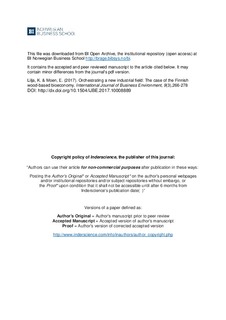Orchestrating a New industrial Field. The case of the Finnish wood-based bioeconomy
Journal article, Peer reviewed
Accepted version
Permanent lenke
http://hdl.handle.net/11250/2477751Utgivelsesdato
2017Metadata
Vis full innførselSamlinger
- Publikasjoner fra CRIStin - BI [1015]
- Scientific articles [2181]
Originalversjon
International Journal of Business Environment. 2017, 9 (3), 266-278. 10.1504/IJBE.2017.10008889Sammendrag
The article's focus is on how companies and institutions interact and cooperate in order to develop the wood-based bioeconomy field. Based on a case study of the Finnish forest sector, the paper shows that shifting to sustainability requires processes of co-creation. As radical innovation requires complementary competences, companies have had to cooperate with a large number of actors. By interacting with multiple actors at multiple levels, both companies and institutions have engaged in new types of activities that have led to a change in their respective roles. By taking on responsibility for developing the new industrial field, both companies and institutions act as orchestrators for mobilising a large number of public and private actors. Subsequently, the paper argues that this interaction has produced a new type of complementarity between companies and institutions facilitating the development of the new industrial field.The article's focus is on how companies and institutions interact and cooperate in order to develop the wood-based bioeconomy field. Based on a case study of the Finnish forest sector, the paper shows that shifting to sustainability requires processes of co-creation. As radical innovation requires complementary competences, companies have had to cooperate with a large number of actors. By interacting with multiple actors at multiple levels, both companies and institutions have engaged in new types of activities that have led to a change in their respective roles. By taking on responsibility for developing the new industrial field, both companies and institutions act as orchestrators for mobilising a large number of public and private actors. Subsequently, the paper argues that this interaction has produced a new type of complementarity between companies and institutions facilitating the development of the new industrial field.
Beskrivelse
The accepted and peer reviewed manuscript to the article
